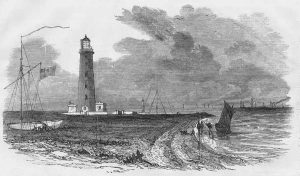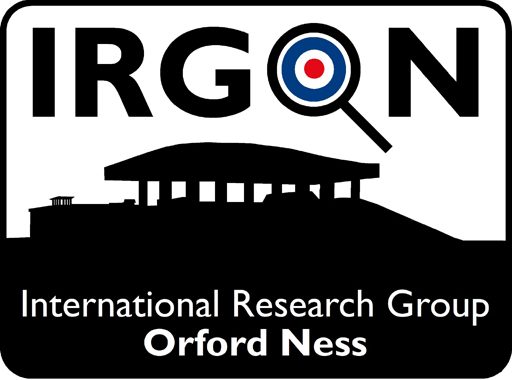
There were several phases of experimental military research in the 20th century on Orford Ness, all of which have left structures and other remains. The work conducted here by some of the greatest ‘boffins’ of past generations played a crucial role in winning the three great wars of the twentieth century: the two World Wars and the Cold War.
WW1
Following the purchase by the government of Orford Ness in 1913, the Army Air Corps Experimental Flight built Orford Ness airfield. It opened in 1915, with a large grass airfield with canvas hangars, labs, workshops and an accommodation camp. At its peak, 600 scientists, technicians, pilots and support staff were involved with military activities. A substantial technical capability was quickly created to evaluate and develop aerial gunnery, bombs, gunsights, tactics, camouflage, photography and navigation. The product of this work was transferred to the battle front in France on a continuous basis. Scientific staff, drawn from universities, working with technical teams to create numerous innovative developments through to the armistice in 1918.
Interwar
Following WW1, facilities on Orford Ness were mothballed for several years. It then became a centre for the study of bomb ballistics (the study of unguided gravity bombs) due to its remote location by the sea. The Bomb Ballistics Building was constructed in 1933 along with high-speed cameras and recording equipment. Radio telemetry was developed to transfer data from the falling bomb to the control room in later years. Orford Ness became a centre for radio research with the building of the Black Beacon navigation transmitter in 1929. In 1935 Robert Watson Watt and his small team based at Orford Ness succeeded in transmitting a 6MHz radio signal that detected the presence of a distant aircraft with the resulting reflected signal. Following this demonstration, his team was greatly expanded and moved to nearby Bawdsey Manor to develop a full operational Radar system. This work resulted in the building of a large network, starting in 1939, with 21 stations known as Chain Home. The system continued to expand and proved to be very effective during the Battle of Britain.
WW2
Orford Ness developed and improved its bomb ballistics capability, enabling very large highly destructive weapons to be developed. Captured enemy aircraft were evaluated for their vulnerability for onward briefing to aircrew and feedback to allied aircraft designers. In 1944, highly effective radar guided gun batteries using proximity fused ammunition were deployed on Orford Ness to deal with V1 flying bombs heading for the London area.
Post war
In the period following WW2, Orford Ness continued to be operated as an outpost of the Royal Aircraft Establishment, known as the Orfordness Research Station. Part of the establishment was transferred in the mid-1950s to AWRE.
AWRE
In 1947, following the McMahon Act, the US government excluded the UK from any further nuclear weapon development collaboration. This resulted in the UK government creating its own nuclear weapons programme directed by Dr William Penney, initially based at the existing Fort Halsted facility in Kent. In 1950 RAF Aldermaston was selected as the new location for the programme and in 1952 the redeveloped site was officially named as the Atomic Weapons Research Establishment (AWRE), with William Penney as its Director. In January 1955, the AWRE became part of the UK Atomic Energy Authority (UKAEA), incorporating the nearby Royal Ordnance Factory Burghfield and the part of the Orford Ness test range. Aldermaston steadily developed a succession of nuclear weapons and technologies over the following years. In 1971 AWRE withdrew from Orford Ness. Some years later, in 1987, the AWRE was renamed ‘AWE’ the Atomic Weapons Establishment, and in 1991 Lord Penney, its founder, died. The AWE has continually developed its capabilities over the years and currently employs around 6000 staff who provide the warheads for the UK submarine based nuclear deterrent.
Eras
Themes across eras
1792
Last lighthouse completed

1853
Submarine cable Orford Ness - Scheveningen
1914
War Office purchases Orford Ness
1915
Airfield established
April 1916
No. 37 Sqn RFC formed at Orfordness. Shortly afterwards, merged with the station establishment for the formation of a new RFC Experimental Station. (DEFE 71/48)
June 1917
 Zeppelin shot down
Zeppelin shot down
October 1917
Became known as the Armament Experimental Station. (DEFE 71/48)
September 1919
Reduced to care and maintenance basis, under control of the Aeroplane Experimental Station, Martlesham Heath. (DEFE 17/48)
June 1921
Orfordness closed, and handed over to Works and Buildings. (DEFE 71/48)
March 1924
ON re-opened as an emergency landing ground and also bombing and gunnery trials. Personnel sent over from Martlesham as required. (DEFE 17/48)
1928
Black Beacon built by RAE
1929
 Bomb ballistics using dugout
Bomb ballistics using dugout
1933
Bomb Ballistic Building built to house equipment relating to bomb ballistics. http://irgon.org/bomb-ballistics
January 1934
The Bomb Ballistics building was handed over to RAF Martlesham Heath and a programme of research was authorized by the Air Ministry.
May 1935
The old airfield at Orfordness was taken into use as a research station for RDF (later known as radar), manned by scientists of the National Physical Laboratory under the direction of Air Ministry. (DEFE 71/48)
September 1939
The Air Firing research station at Orfordness was placed under the administration of RAF Martlesham Heath. (DEFE 71/48)
15th May 1940
A Dutch pilot, Justus Heyman, escaped from Holland in a light aircraft, and managed to land on Orford Ness, in spite of erected obstacles.
March 1945
The RAF section Martlesham disbanded, following which the RAF interests at Martlesham Heath and the Orfordness Research Station were looked after by RAF Felixstowe. (DEFE 71/48)
May 1946
The Bomb Ballistics Unit (later to combine with the Blind Landing Experimental Unit to become the Armament and Instrument Experimental Unit) moved into Martlesham Heath and used the ranges at Orford Ness. (DEFE 71/48)
August 1946
Firing trials of the German R4M aircraft rocket were carried out against British heavy bomber aircraft structures.

March 1950
Firing trials carried out on Orford Ness with Swiss 20mm and 30mm ammunition. Weapons evaluated were the Hispano Suiza Type 820 and 830 autocannon, and comparison was made with British Hispano No.3 Mk. V
April 1956
 AWRE Lab 1 was handed over
AWRE Lab 1 was handed over
13th February 1960
The first French nuclear test Gerboise Bleue at Reggane in the Sahara was detected by an AWRE team on Orford Ness. see Nuclear detection: phase 1
1st April 1960
Gerboise Blanche,
the second French nuclear test in the Sahara, was detected by AWRE staff on Orford Ness.March 1971
 Cobra Mist, 6 March 1971
(c) Bryn Campbell
Cobra Mist, 6 March 1971
(c) Bryn Campbell
Cobra Mist starts test transmissions. See COBRA MIST
29th June 1973
 Cobra Mist was permanently shut down at 17:30 Zulu.
Cobra Mist was permanently shut down at 17:30 Zulu.
Navigate the timeline using the arrow keys.
